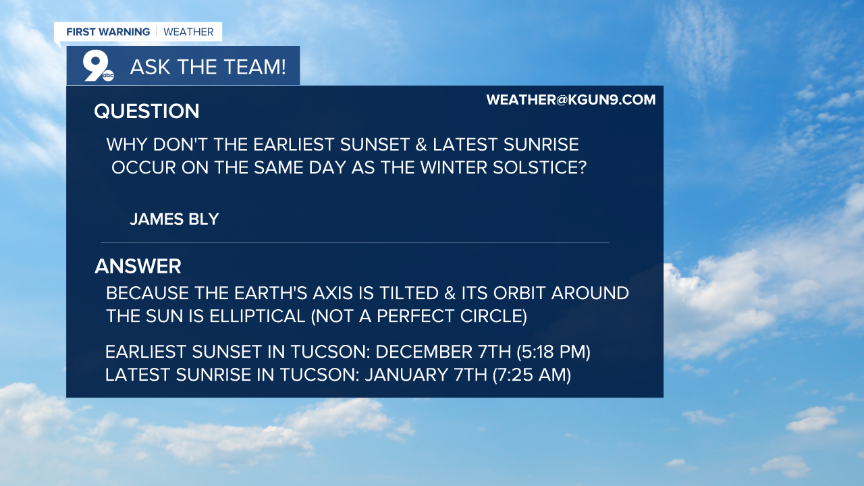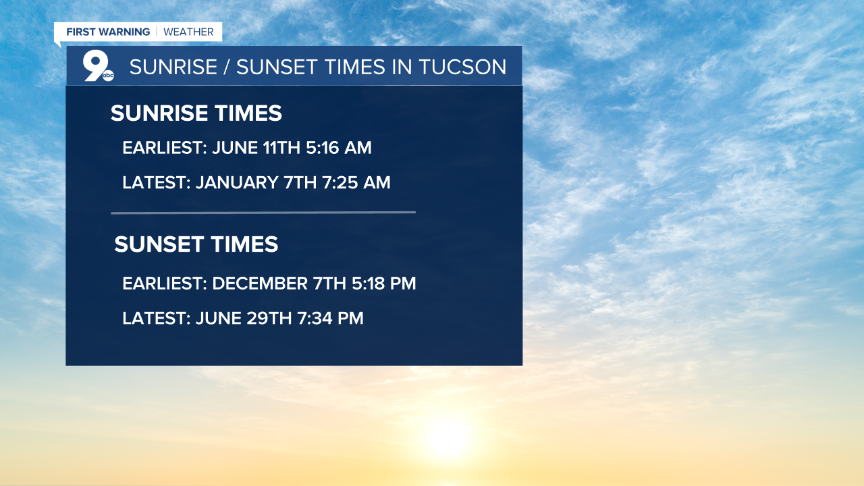TUCSON, Ariz. — We have entered the time of year where we really notice the loss of daylight because of earlier sunsets and later sunrises. We usually think of the winter solstice as the official start of winter and the day with the least amount of daylight of the entire year. One would assume that this day would also bring our earliest sunset and our latest sunrise.
Not so fast!
Some of us notice the earliest sunset occurs before the solstice and the latest sunrise occurs after the solstice.
KGUN 9 viewer, James Bly, noticed and asked the First Warning Weather team for an explanation as to why the earliest sunset occurs in early December and the latest sunrise occurs in early January. The answer isn’t as simple as one might think, but we’re here to shed some light on our winter darkness and explain the sunset/sunrise question!

The main reasons for the earliest sunset to occur in early December and the latest sunrise to occur in January are the fact that Earth’s axis is tilted (23.5°) and Earth’s orbit around the sun is not a perfect circle shape. Instead, the shape of Earth’s orbit around the sun is an elliptical shape.
Now here’s where it gets a little tricky. Earth’s tilt and its elliptical orbit shape create a discrepancy between true solar noon (the time of day when the sun reaches its highest point in the sky relative to where we are standing) and the noon hour we see on our clocks. In other words, let’s imagine we’re standing close to a sundial right about noon. Most days, the sundial would indicate high noon at a different time than our cell phones or watches.
To determine why we get the earliest sunset before the solstice and the latest sunset after the solstice, we need to forget the clock time and focus on the true solar noon. Early in December, solar noon actually occurs almost 10 minutes earlier than it does on or near the 21st of December. This results in solar noon coming later when we get to the actual day of the solstice. This causes the sunrise and sunset times to occur later on the day of the solstice. Behold! The tilt, the elliptical orbit shape and true solar noon all come together to produce the earliest sunset in early December and the latest sunrise in early January!
If you’re really confused right about now, you’re not alone. Just remember the basics. The reason for the odd sunset and sunrise times versus the solstices is because the Earth is tilted and it orbits the sun in an elliptical shape and not a perfect circle.
Okay, time to move on to things we can all understand. Sunrise and sunset times.
The specific sunrise and sunset times will vary depending on our latitude. If we live closer to the North Pole, we’ll see much less daylight in the winter than folks who live closer to the equator. Here in southern Arizona, we’re close to 32° N, so we don’t see the wild swings in daylight loss and gain that our friends to the north see throughout the year. Even so, we experience a significant loss of daylight between the summer solstice and the winter solstice.

In Tucson, our earliest sunset occurs on December 7th at 5:18 pm. We actually reach 5:18 pm on November 27th and stay in the 5:18 pm window through December 8th.
Our latest sunrise occurs on January 7th at 7:25 am. Similar to reaching the earliest sunset time, we actually see a sunrise in the 7:25 am window from January 4th through January 12th.
The bottom line is, in the afternoon, we gain about 7 minutes of daylight by the time we get to Christmas. However, in the morning, we’re still losing about 3 minutes of daylight after Christmas.

This is all fun to think about and gives us inspiration just about the time we’re thinking the nights are so long as we head into winter. Plus, after reading this article, think how you can impress your friends and family with the technicalities of the sunrise and sunset times around the time of the solstice!
The next time you hear someone say the solstice is the shortest day of the year, you can confidently let them know that it is the day with the least amount of daylight. However, it is not the shortest day. Technically, it’s actually the longest day of the year at 24 hours and 30 seconds based on the sun.
This always makes for great conversation and debate around the holidays! Have fun and enjoy your extra 7 minutes of afternoon daylight on Christmas Day!







